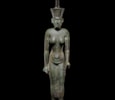The Goddess Neith
Bronze statue of the goddess Neith, striding, her left foot extended forward. Her left hand is extended forward and formally held a papyrus sceptre, a fragmentary ankh is visible in her right hand. She wears a close-fitting sheath dress, incised with a broad usekh collar, and carefully engraved bracelets and armlets. On her head is the Red Crown of Lower Egypt, decorated with vertical striations and restored spiral and spire. Her face is finely molded, with a broad upturned nose and electrum-overlaid eyes and eyebrows.
Neith was one of the earliest recorded gods in the Egyptian pantheon, worshipped from early in the Predynastic era through to the arrival of Roman rule. A war goddess and goddess of weaving, she was the patron goddess of the Red Crown of Lower Egypt and the city of Zau (Sais, in the 5th Nome of Lower Egypt) in the Delta. A powerful and popular goddess, she was, according to the Iunyt (Esna) cosmology, the creator of the world and the mother of the sun, Ra. This made her the mother of all of the gods, who often came to her to settle their disputes.
Her symbols are the bow and arrows and a sword and shield as a war goddess, a weaving shuttle as a funerary goddess, and the Red Crown of Lower Egypt as goddess of creation and mother goddess. She is usually depicted, as here, as a woman wearing the Red Crown of Lower Egypt, however, she is occasionally depicted as a cow in connection with her role as the mother of Ra.
The use of electrum, a naturally occurring alloy of gold and silver sometimes called ‘green-gold’, for the eyes speaks to the high status of the object. Electrum had been used by the Egyptians since at least the 3rd millennium B.C., but, give its rarity, was reserved for the most expensive and important objects. Most electrum used in Egypt was imported from Nubia, though some was found there.
Parke-Bernet Galleries, New York, February 25th, 1971, no. 70, illus.
Sotheby’s, New York, June 5th, 1999, no. 31, illus.
David Aaron Ltd, 2023, No. 28.
Previously in the Private Collection of Albert Roothbert (1874-1965) and Toni von Horn (1899-1970) New York and Ridgefield, Connecticut, from at least 1928 (accompanied by a photograph of the bronze by photographer Arnold Genthe, dated 1928).
Topstone Fund, New York (a foundation set up by Roothbert and von Horn, named after their farm on Topstone Road, Connecticut). Bequeathed on von Horn’s death in 1970.
Sold: Parke-Bernet Galleries, New York, February 25th, 1971, no. 70.
With Allan Caplan Trust, New York, acquired at the above sale.
Sold: Sotheby’s, New York, June 5th, 1999, no. 31
Private Collection, acquired at the above sale.
ALR: S00224371, with IADAA Certificate, this item has been checked against the Interpol database.
Albert Roothbert (or Rothbart, or Rothbert, 1874-1965) was an investment banker who was born in 1874 in Frankfurt, Germany to a long assimilated German Jewish family that had lived in that city since 1504. He emigrated to the United States in 1902 and became a partner in the investment firm Hallgarten & Co. He had a keen interest in art and archaeology, and in 1926 his collection of modern art was sold at Anderson Galleries to great acclaim. In the introduction to the sale, he stated that the purpose of the sale was, in part, to indulge in ‘the hunt for new prizes’, as his collection had grown to such a size that accommodating new acquisitions was becoming difficult. His interest in the Pharoah Akhenaten led him to sponsor an archaeological mission led by Prof. Hermann Junker of the University of Vienna.
In 1936 he met, and married, German fashion photographer Antonie ‘Toni’ van Horn (1899-1970), who was the first woman to join the stable of Conde Nast’s Vogue and Vanity Fair in the 1930s. Active as Tony von Horn, her images were regular features, along with such luminaries as Edward Steichen, Adolf de Meyer and George Hoyningen-Heunes, in the magazines from the end of 1930 to 1935. The Roothbert’s lived on a beloved farm in Connecticut, on Topstone Road. The Topstone Fund, which Albert had run for some time, is named after their property.
Together, in 1958 Albert and Toni created The Roothbert Fund, a scholarship fund dedicated to promoting the idealism and education of young people, who, in the wake of the Second World War Albert Roothbert believed, would "create a new, more enlightened society, which will want to live democratic principles, not merely claim them."
Albert Roothbert was friends with the famous photographer Arnold Genthe, who photographed the Neith in 1928. In his autobiography, Genthe described his relationship with Roothbert: "Of Albert Rothbart, one of the few bachelors among my friends, I see a great deal when he is not traveling about in distant corners of the world. We have many tastes in common but disagree about a sufficient number of things so as to make talk always interesting. I enjoy our friendly rivalry shown not only in candid camera experiments but at auction sales and on cross-country rides."










 Enquire
Enquire




